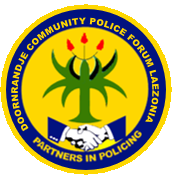COMMUNITY SAFETY PLAN
FOR
{AREA}
INTRODUCTION
The purpose of a community safety plan is to provide a framework for identifying and mitigating safety risks to which the community is exposed. It directs community efforts in the most productive way, and promotes strategic, tactical and operational partnerships with other stakeholders, including SAPS, security companies operating in the area, the local municipality, and neighbouring areas.
The steps in formulating a community safety plan are:
- Specify the area to which it applies.
- Set community safety objectives.
- Identify risks to community safety.
- Classify the risks as high, medium or low.
- Decide overall response to each risk: treat, transfer, tolerate or terminate.
- Identify mitigation(s) for each risk.
- Develop a time-based community safety action plan.
- Implement the plan.
- Monitor and evaluate results.
- Implement corrective actions and other improvements as appropriate.
CONSTRUCTING THE COMMUNITY SAFETY PLAN
Date
Objectives
• What must be achieved?
• What are the time lines
• Are the objectives achievable in the time you have set?
• How will you measure success?
• Take a critical look at your objectives – are they relevant to your area at this time?
List the objectives of the Community Safety Plan:
Risks to community safety and security
• List everything that poses a risk to community safety.
• Include internal risks, eg leaving gates open, not repairing fences, etc.
• List risks originating externally, eg pedestrian and vehicle traffic originating outside the area, etc.
• Identify vulnerable areas, eg entrance roads, borders with access roads, etc.
• Identify vulnerable properties, eg poor condition of fences, no alarm, people living alone, properties regularly targeted by criminals, etc.
• Identify times of day, week, month, year where crime is more frequent.
List the risks to your community:
Classify risks
• Resources are usually limited, and a way of classifying risk is needed, so that sufficient resources are allocated to the most serious risks.
• There are many ways of doing this; some are unnecessarily complicated. Keep it simple by using a classification of HIGH, MEDIUM and LOW.
• High – likely to happen and has serious consequences.
• Medium – quite likely to happen, but the consequences are less serious.
• Low – fairly unlikely and the consequences are relatively trivial.
Decide on the type of response to each risk
• Four classes of response are often used: treat, transfer, tolerate, terminate.
• Treat – mitigate the risk by taking action to address it so that it is either removed or eliminated.
• Transfer – move the risk to someone else,, eg insuring household contents. Useful of individuals but cannot usually be used to address community safety risks.
• Tolerate – do nothing because the issue is unlikely to arise, and will have minimal consequences if it does.
• Terminate – cease the activity which poses the risk. This is probably going to prove impossible in the context of community safety.
• From the above, it appears that the practical solution to community safety is to either treat risks or tolerate them
Revisit the list of risks on the previous page. Classify as high, medium or low. Decide whether to treat or tolerate.
When you have classified the risks, you are ready to formulate the Community Safety Plan.
COMMUNITY SAFETY PLAN FOR DATE
| SAFETY ACTION PLAN | MONITORING |
| SAFETY ACTION PLAN | MONITORING | |||||||
| RISK | H – M – K | MITIGATION | WHO? | WHEN? | DATE | WHO? | EVALUATION | CORRECTIVE ACTION |
Views: 36





